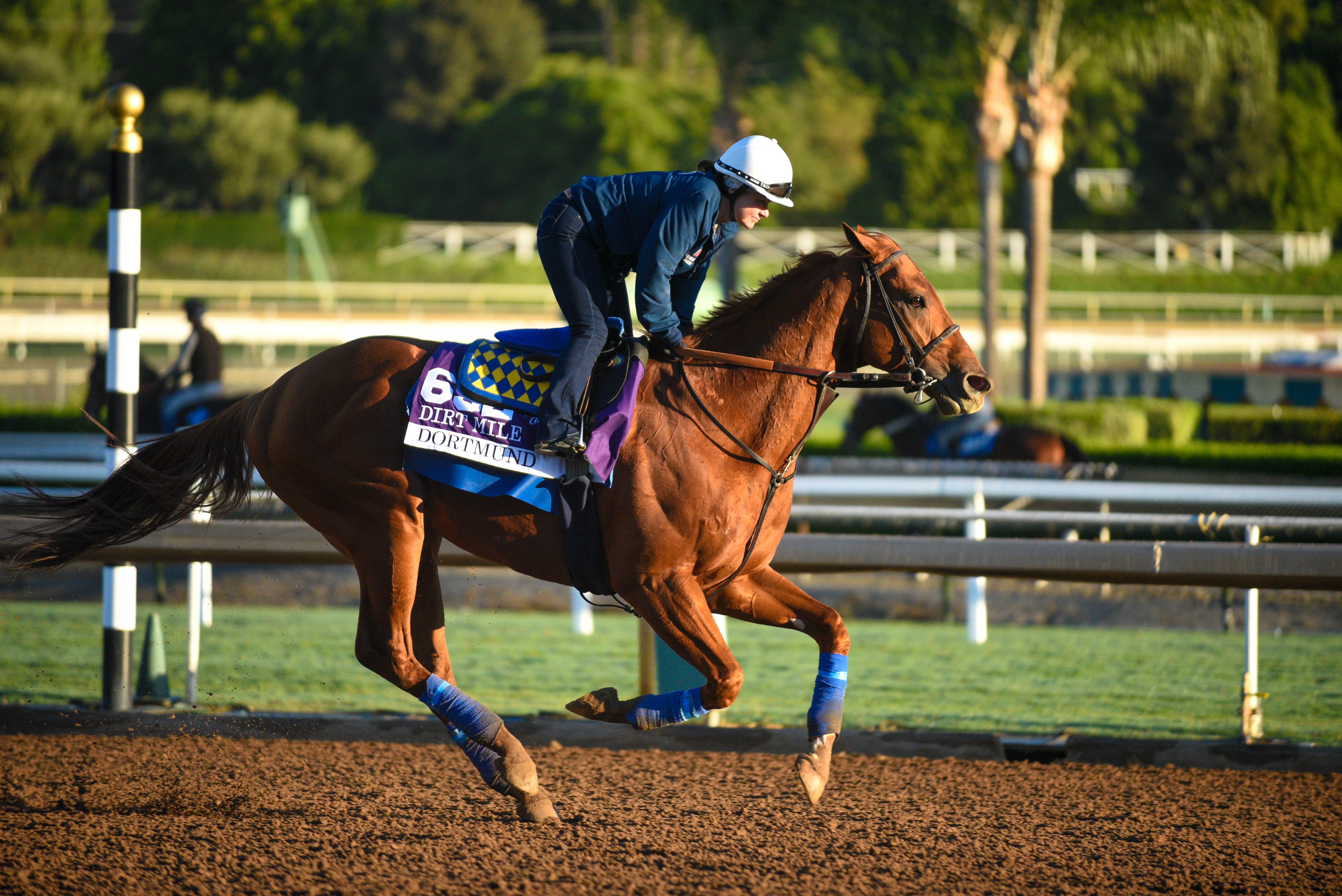The middle-distance Breeders’ Cup races rarely are the headliners and often are the most likely races to be overlooked on a packed weekend of championship racing. For bettors, however, these races offer some of the best opportunities to catch prices, and you’ll need them if you want to cash-in on a couple of the year’s most lucrative Pick 4s on Friday and Saturday, Nov. 3-4.
As one of the original seven Breeders’ Cup events, and with a $2 million purse, the Mile is guaranteed to draw an international all-star field of the world’s top turf milers. Through its 33-year history, the Mile has been somewhat of an enigma for horseplayers who seem overanxious to designate it as being overwhelmingly dominated by European invaders. This is despite evidence to the contrary, however, which suggests Americans do equally well and, annually, have a better-than-average chance to win.
The Breeders’ Cup Dirt Mile, meanwhile, is an interesting handicapping puzzle for horseplayers and will play a key part in the Breeders’ Cup Friday festivities at Del Mar. Instead of letting this race become a Friday “all-button” toss-up that exponentially expands the cost of your exotics tickets, I suggest using a few solid angles based on past results to help narrow down the field to only a few serious contenders.
Here are some tips to help you attack the middle-distance Breeders’ Cup race — the Mile and Dirt Mile.
Handicapping the Breeders’ Cup Mile
In 33 editions of the Breeders’ Cup Mile to date, not counting horses that began their careers in Europe and then came to the United States, foreign invaders have won 13 times and accounted for only 39% of the winners of this race. Based on this, you can hardly toss the Americans when doping-out the Mile, especially when the Americans now have won two Miles in a row and five of the last six.
With the exception of Goldikova, the only foreign invader to win the Mile since Six Perfections way back in 2003 was Karakontie in 2014.
Another difficulty in smoking-out the Mile winner is the fact that the race has never been dominated by any one age group — or by either sex. Throughout the history of the Mile, the race has been won nine times by females. Eight of those nine years it was a filly, and 3-year-old fillies in particular have done extraordinarily well in this race over the years, winning four times.
Including those fillies, a total of nine 3-year-olds have won the Mile. That is nearly equal to the total of 11 horses aged five or older that have won the race, including last year’s winner Tourist. The 13 other winners were 4-year-olds.
So, if a handicapper cannot weed-out contenders in the Mile by age, sex, or national origin, how can we narrow down what figures to be a full and wide-open international field of evenly-matched challengers? Let’s start by looking at angles based on odds and especially pace.
Pace
The frontrunner, or any horse involved in the early pace, almost never wins the Breeders’ Cup Mile. With the exception of Hall-of-Famer Lure in 1992-93, no other pacesetter has ever have won the Mile in its long history. Tepin in 2015 was as close to the pace as any horse since Lure, when she raced just a length behind the early leader. She joined Kip Deville in 2007 and Goldikova in 2008 as Mile winners who’ve employed the pace-pressing running style.
When you look at the 33-year results of the Mile, you will notice that the overwhelming majority of the winners have used a late-closing or a stalking running style en route to victory. Not only is it tough for a speed horse to win this race, but it’s also very difficult for even a pace-presser to win.
This is the number one strongest handicapping angle in the Mile: Bet the stalkers and closers and bet against speed horses and need-the-lead types to win the race.
An unrealistic pace once again cooked the front-runners in 2016 and set up Tourist and Tepin perfectly from off the pace for a 1-2 finish.
Odds
As mentioned above, we have seen horses win this race as big favorites or as giant bombs. The North American horses cannot be counted out against the foreign invaders, and horses of all ages and sexes, including 3-year-olds and 3-year-old fillies, must be respected.
You cannot simply just toss out horses in this race because they’re 30-1 when you are faced with a race in which it may be more beneficial for bettors to toss-out Europeans who are 3-1. With the exception of the great ones like Goldikova and Miesque, foreigners mostly have burned a lot of money in the Mile down through the years. This consistent failure of foreign invaders makes the odds a valid handicapping angle in the Mile.
In terms of odds, the best advice is, unless there is an international superstar beast in this race the likes of Lure, Goldikova, Wise Dan, or Miesque, the favorites are worth betting against — especially if the favorite is a foreign invader. When betting to win and rounding out the exotics, take the North American overlays and imports that at least have a North American race under their belts, in a race such as the Woodbine Mile or Shadwell Turf Mile.
2017 Mile Contenders
The list of Mile contenders for 2017 begins with the U.S. divisional leader World Approval, who comes in off back-to-back Grade 1mile wins in Saratoga’s Fourstardave and the Woodbine Mile. World Approval also added a Grade 2 win in the Dixie Stakes at Pimlico this season, and was last defeated in the Manhattan Stakes when stretched out to 1 ¼ miles. At this mile distance, however, he will take considerable beating at Del Mar. World Approval also is a brother to a former BC Mile winner, Miesque’s Approval (2006).
The other top contender is winner of the Grade 1 Shadwell Turf Mile, Suedois, who looks a lot better now that he has a North American outing under his belt. Sudeois knocked around Europe at 6-7 furlongs for his career until apparently becoming a new horse when stretched out to a mile two races ago to win a Group 2 mile event at Leopardstown. He has the right late-running style for success in this spot, and appears to have benefitted from the Lasix he added last time out.
The European contingent for this race this year is highly questionable, in my opinion. Leading contender Ribchester will ship to Del Mar to run off just two weeks rest after losing at Ascot on Oct. 21. The 4-year-old winner of the Prix du Moulin de Longchamp is unquestionably good enough, but he has the look and smell of the latest short-priced Euro to go down in flames in this race.
Aiden O’Brien’s Churchill fits the same bill. His preference is the Classic, but if the connections choose to run in the Mile, he will ship with two weeks between races after finishing third in the same race at Ascot as Ribchester. Before that he was a seventh in the Irish Champion Stakes and seemed much better earlier this season than he does now.
Another foreign invader is Decorated Knight, but his preference is the Turf and he will be distance challenged (too short) in the Mile. That leaves Aiden O’Brien’s Lancaster Bomber — but, as a confirmed frontrunner, he has the wrong running style for success in this race.
Speaking of the wrong running style, that may be the downfall of Heart To Heart in this race. The 6-year-old finished second in the Shadwell Turf Mile but did so after setting a far easier pace than is projected in the Breeders’ Cup.
The Californian with the best chance to win is Obviously Mile winner Blackjackcat, who has reeled off four straight wins including the Del Mar Mile, but will need to be able to rate better if he’s to win this race because it’s doubtful he’ll go wire-to-wire.
Conclusion
Only a couple horses fit the profile of a Breeders’ Cup Mile winner. Go with WORLD APPROVAL and SUEDOIS. Bet against the foreign invaders on top, limiting the use of those horses to the bottom of exactas, trifectas and superfectas.
***
The Inside Dope on the Breeders’ Cup Dirt Mile
By Noel Michaels
Originally published on October 31, 2017
The Dirt Mile has always been something of a consolation prize for horses that are not good enough to point for the Classic and not fast enough to point for the richer Sprint. What we usually are left with in the Dirt Mile is a mishmash of contenders from across the county who must either stretch out from a sprint or cut back from a route in order to fit into this in-between spot in the Breeders’ Cup.
The 2016 Dirt Mile champion, Tamarkuz, knocked-off a field that included Gun Runner and heavily-favored Dortmund and, in so doing, ended a two-year run of extreme chalk in the race. Goldencents captured this race in 2013 and 2014 (paying $9.60 and $3.40 to win, respectively). He was followed by Liam’s Map, who was by far best in 2015, to the tune of $3.00 to win.
Looking at the past results of the Dirt Mile, whether it was run on dirt or all-weather, a few trends jump out at you as a handicapper. These tips can help you narrow down the field in the Dirt Mile. There are now 10 years of Dirt Mile results to comb through for trends.
Here is a summary of what these trends point to in the Dirt Mile:
- Bet Horses with winning route ability, not Sprinters.
- Hot paces usually cook the speedsters in this race, so look for stalkers/closers.
- Look for a price and bet against underlays, particularly Baffert underlays.
Before going any further, it should be mentioned that Goldencents was a repeat winner of this race who bucked the trends, thanks in part to strong early speed biases at Santa Anita on the Fridays of the 2013 and 2014 Breeders’ Cups. This teaches us, among other things, that handicappers have to be keenly aware of track biases and other factors affecting the results earlier on Breeders’ Cup weekend (and on the card) before proceeding.
But back to the angles: In the first six years of the Dirt Mile, the race was won by a route horse cutting back in distance rather than a sprinter trying to stretch out. Horses that have performed well in longer races, but exit one sprint prep are okay too. This was the case with Goldencents, who had sprint prep races before winning the 2013-14 Dirt Miles, but was already established and proven as a high-quality mile and route performer during his career.
The 2016 winner, Tamarkuz, was a true-blue miler and came into the Dirt Mile off a troubled second-place finish in one of this race’s prime prep races, Belmont’s Kelso Handicap. Liam’s Map completely fit this category in 2015. He was a route horse exiting a Grade 1 win in a two-turn 1 1/8-mile race.
The pace of the Dirt Mile is always blazingly-fast for a two-turn race and sprinters just can’t cut it going that fast for that long.
This is the number one most effective handicapping angle in the short history of the Dirt Mile: Bet horses with proven route ability, even if their last race was a sprint, because contenders need enough “bottom” to be able to withstand a fast pace all the way to the finish.
The presence of stretch-out sprinters in the Dirt Mile every year guarantees the pace of the Dirt Mile will be blazingly fast. This being the case, closers get great set-ups in the Dirt Mile. In 10 editions of the Dirt Mile, the race has been won by a stalker or closer seven times. The exceptions were Goldencents, who was the only horse in the history of this race to be dominant on the front-end (with the help of speed biases). The other was upset pace-pressing winner Tapizar in 2012.
The ideal type of horse in this race seems to be one that can stalk the pace or rally from farther behind. The stretching-out sprinters in this field will bottom-out and cannot close; and the speed horses get cooked on paces that tend to be way too fast.
Therefore, expect stalkers or closers to be the main candidates to win the 2017 Dirt Mile. Expect these horses, along with perhaps one quality front-runner, to capture all major spots in the exotics. Betting speedsters or stretch-out sprinters does not appear to be the way to cash in the Dirt Mile.

A heavy favorite, Dortmund was defeated in the 2016 Breeder’s Cup Dirt Mile by Tamarkuz.
Finally, aside from aforementioned big favorites Liam’s Map and Goldencents, as mentioned above, the Dirt Mile typically goes to a longshot. In fact, a price horse scored again in 2016 and the average Dirt Mile winning payoff is $23.60 (about 10-1 odds). When you remove the shortest-priced and longest-priced winners from the equation, the average payoff is still $19, or around 8-1 odds.
We can say that, ideally, you are looking for either a clear standout horse that is a single in your exotics like Liam’s Map or Goldencents, or, absent that, a contender that is in the 10-1 odds range.
In the list of 2017 Dirt Mile contenders, we have horses exiting wins in most of the year’s key middle-distance races including the Metropolitan Mile, Belmont’s Kelso Handicap, Churchill’s Ack Ack, Saratoga’s Allen Jerkens (formerly the King’s Bishop), plus the winner of the Governor’s Cup at Remington Park and the top finishers from the Awesome Again at Santa Anita.
The key prep race winners will all be trying to defeat the likely favorite of the 2017 Dirt Mile, Accelerate, who hasn’t finished off the board in six 2017 starts, including a win over Arrogate in the San Diego Handicap at Del Mar.
You can poke holes in the credentials of most other major contenders in the 2017 Dirt Mile. Mor Spirit won the prestigious Met Mile for trainer Bob Baffert, but that was in June and he has not run since and will enter the Breeders’ Cup without a prep.
Sharp Azteca is a top-class sprinter, and did stretch out to win Belmont’s key prep for this in the Kelso Handicap. As a sprinter trying to stretch out, however, Sharp Azteca does not fit the profile of a winner of this race. Also note that the Kelso is a one-turn race, and the Dirt Mile at Del Mar will be two turns. Two turns is also a problem for Practical Joke, who is 5-for-5 going one turn but 0-for-5 at two turns. The Jerry Hollendorfer-trainer Battle Of Midway will attract a lot of money at the windows, but he enters off a loss in the Oklahoma Derby with only a 91 Beyer speed figure.
Horses coming into the Dirt Mile the right way — with the right profile and at the right odds — include some lower-profile contenders and offer some alternatives to Accelerate. They are:
- Awesome Slew, who was cut back and converted to a late-running, middle-distance horse this year for trainer Mark Casse. He lost to both Mor Spirit and Sharp Azteca in the Met Mile (one turn) earlier this year, but has improved since then, beaten only by Drefong in the seven-furlong Forego at Saratoga and, then, scoring in the Ack Ack at Churchill on Sept. 30.
- Iron Fist, who is flying under the radar but, nevertheless, earned his way into this field for Steve Asmussen with wins in a variety of types of races this year in the Maxxam Gold Cup at Sam Houston, the Evangeline Mile Handicap, the Cornhusker Handicap at Prairie Meadows and, most recently, in the Governor’s Cup at Remington. Also placed in the West Virginia Governor’s at Mountaineer and is a force around two turns at distances from 8 to 9 furlongs.
- Giant Expectations, who will be a price for Peter Eurton coming off a fifth-place showing in the Santa Anita Sprint Championship, but this is a horse that is better with more distance and his profile is similar to that of Goldencents, who cut back into the SA Sprint Championship and lost that race twice before coming back to win the Dirt Mile both times in his next start.
Conclusion
Box Accelerate, Awesome Slew, Iron Fist and Giant Expectations, and use all four of those candidates in your multi-race wagers.




